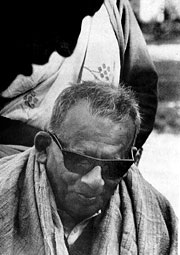Benode Behari Mukherjee
| Binod Behari Mukherjee | |
|---|---|
 |
|
| Born | February 7, 1904 West Bengal, India |
| Died | November 11, 1980 (aged 76) India |
| Nationality | Indian |
| Known for | painter |
| Movement | Contextual Modernism |
Benode Behari Mukherjee (Bengali: বিনোদ বিহারী মুখার্জি) (7 February 1904 – 11 November 1980) was an Indian artist from West Bengal state. Mukherjee was one of the pioneers of Indian modern art and a key figure of Contextual Modernism. He was one of the earliest artists in modern India to take up mural as a mode of artistic expression, and his murals display a subtle understanding of environmental and architectural nuances.
Binod Behari Mukherjee was born in Behala, in the state of West Bengal, now recently included into Kolkata (2009 onwards). He taught at Visva Bharati University in Santiniketan.
Mukherjee was born with severe eye problem, being myopic on one eye and blind in the other, he continued to paint and do murals even after he lost his eyesight completely following an unsuccessful eye cataract operation in 1956. In 1919, he took admission in Kala Bhavana, the art faculty of Visva-Bharati University. He was a student of another celebrated Indian artist Nandalal Bose, and a friend and close associate of Ramkinkar Baij, the celebrated sculptor. In 1925, he joined Kala Bhava bijn as a member of the teaching faculty. He inspired many brilliant students over the years, notable among them are painter Jahar Dasgupta, K.G. Subramanyan [1], Beohar Rammanohar Sinha [2], sculptor & printmaker Somnath Hore, designer Riten Majumdar and filmmaker Satyajit Ray. In 1949, he left Kala Bhavan and joined as a curator at the Nepal Government Museum in Kathmandu. From 1951-52, he taught at the Banasthali Vidyapith in Rajasthan. In 1952, he along with his wife Leela, started an art training school in Mussoorie. In 1958, he returned to Kala Bhavan, and later became its principal. In 1979, a collection of his Bengali writings, Chitrakar was published.
...
Wikipedia
